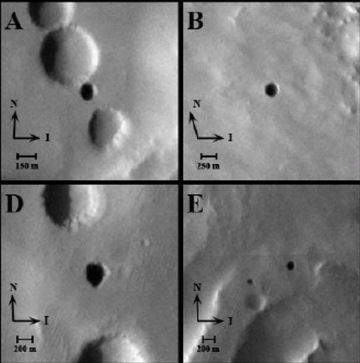Martian Caves
New images taken by a spacecraft orbiting Mars show what appear to be entrances to caves.
Share this:
- Share via email (Opens in new window) Email
- Click to share on Facebook (Opens in new window) Facebook
- Click to share on X (Opens in new window) X
- Click to share on Pinterest (Opens in new window) Pinterest
- Click to share on Reddit (Opens in new window) Reddit
- Share to Google Classroom (Opens in new window) Google Classroom
- Click to print (Opens in new window) Print
By Emily Sohn
Mars is a fully featured world. Scientists have already discovered hills, craters, and dry riverbeds on the Red Planet. New images now show that some parts of the Martian landscape might also be dotted with caves.
If confirmed, these caves “could be among the only places on Mars to find evidence of past or present microbial life,” says Glen Cushing of the U.S. Geological Survey in Flagstaff, Ariz.
 |
|
The small, dark circles in these photographs could be the skylights of caves. The lighter circles are craters.
|
| Cushing et al., NASA |
Cushing and colleagues saw the cave evidence in pictures taken by a camera on the Mars Odyssey spacecraft, which is in orbit around Mars. The camera collects both visible and infrared light.
The images showed seven possible entrances to caverns. The entrances are dark, circular structures, measuring between 100 meters (330 feet) and 250 meters (820 feet) across. All seven openings sit on the sides of a volcano called Arsia Mons.
Scientists don’t know how deep the caves are. The data do show, though, that temperatures within the structures are constant and different from temperatures of the surrounding land. That suggests that they are indeed cave openings.
Caves would be an excellent place to search for life on Mars. Such covered spaces would protect living organisms from the sun’s ultraviolet rays and from micrometeorites, which shower down on Mars like a continual rain.
Cushing’s team is now scouring the rest of the Red Planet for more cavernous evidence. They hope to find caves containing liquid water, which would be even better candidates for harboring life.—E. Sohn
Going Deeper:
Cowen, Ron. 2007. Cavernous findings from Mars. Science News 171(April 14):237. Available at http://sciencenews.org/articles/20070414/note10.asp .
Sohn, Emily. 2005. Evidence of a wet Mars. Science News for Kids (Dec. 14). Available at http://www.sciencenewsforkids.org/articles/20051214/Note2.asp .







